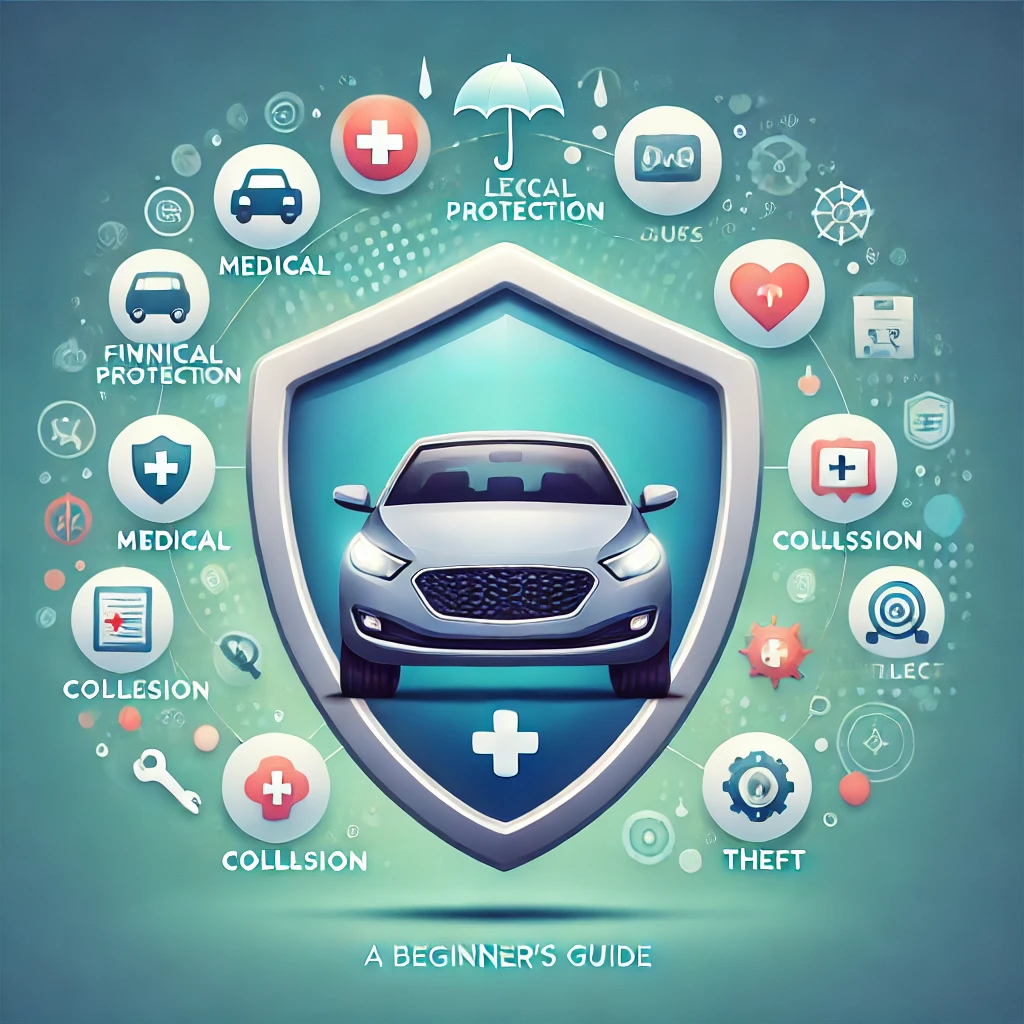Auto insurance is an essential service that provides financial protection against potential risks associated with driving a vehicle. Whether you are a seasoned driver or someone buying their first car, understanding auto insurance is crucial for safeguarding your finances and ensuring compliance with legal requirements. In this comprehensive guide, we’ll explore what auto insurance is, how it works, the types of coverage available, and tips for selecting the right policy for your needs.
What Is Auto Insurance?
Auto insurance is a contract between a vehicle owner and an insurance company. In exchange for periodic payments known as premiums, the insurance provider agrees to cover certain financial losses incurred due to accidents, theft, or other unforeseen incidents involving the insured vehicle.
Auto insurance serves two primary purposes:
- Financial Protection: It helps pay for damages to your vehicle, medical bills, or other liabilities arising from an accident.
- Legal Compliance: In most countries, having auto insurance is a legal requirement for driving on public roads. It ensures that drivers can cover potential damages they may cause to others.
How Does Auto Insurance Work?
Auto insurance operates based on the principle of risk-sharing. Here’s a step-by-step breakdown of how it works:
- Policy Purchase: A driver purchases an auto insurance policy and pays premiums based on factors like their driving history, vehicle type, and location.
- Coverage Activation: Once the policy is active, it offers financial protection according to its terms and conditions.
- Claim Filing: In the event of an accident, theft, or other covered incidents, the policyholder can file a claim with the insurance company.
- Claim Assessment: The insurer evaluates the claim and determines the amount payable based on the policy’s coverage limits and deductibles.
- Claim Settlement: The insurance provider reimburses the policyholder or directly pays for covered damages and losses.
Key Components of Auto Insurance Policies
Auto insurance policies comprise several components that define the extent of coverage and the associated costs. Below are the primary elements:
1. Premiums
The premium is the amount you pay for your auto insurance policy, typically on a monthly, semi-annual, or annual basis. Premiums are calculated based on factors such as:
- Age and Gender: Younger and male drivers often face higher premiums.
- Driving History: A clean driving record can reduce your rates, while accidents or violations may increase them.
- Vehicle Type: Luxury or high-performance vehicles often have higher premiums than standard models.
- Location: Urban areas with higher traffic and theft rates usually incur higher premiums.
2. Coverage Limits
Coverage limits refer to the maximum amount the insurance company will pay for a claim under each category of coverage. Policyholders can choose limits that suit their financial needs.
3. Deductibles
A deductible is the amount a policyholder agrees to pay out-of-pocket before insurance coverage kicks in. Higher deductibles generally result in lower premiums.
4. Policy Terms
Policy terms specify the duration of the coverage, typically six months or one year. Renewing the policy on time is necessary to maintain continuous coverage.
Types of Auto Insurance Coverage
Understanding the various types of auto insurance coverage can help you choose a policy that meets your needs. Here are the main types:
1. Liability Insurance
Liability insurance is mandatory in most regions and covers damages you cause to others. It is divided into:
- Bodily Injury Liability (BIL): Covers medical expenses, lost wages, and pain and suffering for injured parties.
- Property Damage Liability (PDL): Pays for damage to another person’s property, such as their vehicle or home.
2. Collision Coverage
Collision coverage pays for repairs or replacement of your vehicle following an accident, regardless of who is at fault. This type of coverage is particularly important for newer or expensive cars.
3. Comprehensive Coverage
Comprehensive coverage protects against non-collision-related incidents, such as:
- Theft
- Vandalism
- Natural disasters
- Falling objects
4. Personal Injury Protection (PIP)
Also known as “no-fault insurance,” PIP covers medical expenses for you and your passengers, regardless of fault, and may also include lost wages and rehabilitation costs.
5. Uninsured/Underinsured Motorist Coverage
This type of coverage protects you if you’re involved in an accident with a driver who lacks sufficient insurance. It also applies to hit-and-run incidents.
6. Gap Insurance
Gap insurance is particularly useful for leased or financed vehicles. It covers the difference between your car’s actual cash value and the amount you owe on your loan or lease.
Why Is Auto Insurance Important?
Auto insurance is more than just a legal requirement; it provides critical protection in various scenarios:
- Financial Security: Covers expensive repair bills, medical costs, and liability claims.
- Legal Protection: Helps you meet state or country-mandated insurance requirements.
- Peace of Mind: Reduces stress in the aftermath of accidents or theft by providing financial assistance.
- Protection for Others: Ensures victims of accidents receive adequate compensation.
Factors Affecting Auto Insurance Rates
Auto insurance premiums vary widely based on several factors. Understanding these can help you find the best deal:
- Driving Record: A clean record typically results in lower premiums.
- Vehicle Make and Model: Expensive, powerful, or rare cars generally cost more to insure.
- Mileage: The more you drive, the higher your risk of accidents, leading to higher premiums.
- Credit Score: In some regions, insurers use credit scores to assess risk levels.
- Location: High-crime or high-traffic areas can increase insurance rates.
- Age and Experience: Young and inexperienced drivers usually face higher premiums.
How to Choose the Right Auto Insurance Policy
Selecting the right auto insurance policy involves assessing your needs, understanding coverage options, and comparing providers. Here’s a step-by-step guide:
1. Evaluate Your Needs
- Do you drive frequently?
- Is your vehicle financed or leased?
- What are your state’s minimum insurance requirements?
2. Understand Coverage Options
Determine which types of coverage are essential based on your situation. For instance:
- Comprehensive and collision coverage are crucial for new cars.
- Liability insurance might suffice for older vehicles.
3. Compare Quotes
Get quotes from multiple insurance providers to find the best balance of coverage and cost. Use online comparison tools for convenience.
4. Check Discounts
Many insurers offer discounts for safe drivers, bundling policies, or installing anti-theft devices. Inquire about potential savings.
5. Review Policy Terms
Carefully read the fine print to understand coverage limits, exclusions, and deductibles.
Tips for Lowering Your Auto Insurance Premiums
Reducing auto insurance premiums doesn’t mean compromising on coverage. Here are actionable tips to save money:
- Maintain a Clean Driving Record: Avoid accidents and traffic violations.
- Increase Deductibles: Opt for higher deductibles if you can afford them in case of a claim.
- Bundle Policies: Combine auto insurance with home or renters insurance for discounts.
- Install Safety Features: Equip your vehicle with anti-theft systems, airbags, or anti-lock brakes.
- Shop Around: Regularly compare quotes from different insurers.
- Take a Defensive Driving Course: Completing such courses can qualify you for discounts.
Common Myths About Auto Insurance
Myth 1: Red Cars Cost More to Insure
Reality: Insurance rates are based on a vehicle’s make, model, and usage, not its color.
Myth 2: Older Drivers Always Pay More
Reality: Older drivers with a good driving record may qualify for senior discounts.
Myth 3: Filing a Claim Always Raises Your Rates
Reality: Not all claims result in rate increases. The impact depends on fault, claim history, and your policy terms.
What Happens If You Drive Without Auto Insurance?
Driving without auto insurance can lead to severe consequences, including:
- Legal Penalties: Fines, license suspension, or even imprisonment in some cases.
- Financial Liabilities: You’ll be personally responsible for damages or injuries caused.
- Vehicle Impoundment: Authorities may impound your vehicle until proof of insurance is provided.
- Increased Future Costs: A lapse in coverage can lead to higher premiums when you reapply for insurance.
Conclusion
Auto insurance is a vital component of responsible vehicle ownership, offering financial security and peace of mind. By understanding the different types of coverage, factors affecting premiums, and strategies for selecting the best policy, you can make informed decisions that align with your needs and budget. Whether you’re a new driver or looking to switch providers, taking the time to research and evaluate options can ensure you’re adequately protected on the road.







